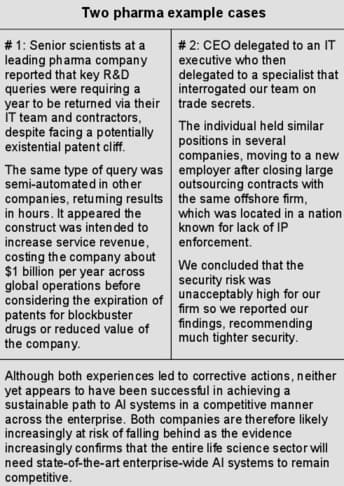When we first approached senior executives about the benefits of our work in AI systems more than a decade ago, we were limited by physical constraints to the small group of organizations who happen to own supercomputers that could perform extreme computing tasks. Obstacles in physics and economics at the time still prevented us from achieving our original goal of distributed AI systems across networks and organizations.
 About five years ago we experienced the modern equivalent of a Sputnik moment when innovations in GPUs combined with earlier breakthroughs in algorithmics to lift off a machine learning revolution that would rapidly expand from a few supercomputers to autos, desktops and mobile devices. This ongoing revolution enabled us to begin discussing AI systems with many life science and healthcare organizations.
About five years ago we experienced the modern equivalent of a Sputnik moment when innovations in GPUs combined with earlier breakthroughs in algorithmics to lift off a machine learning revolution that would rapidly expand from a few supercomputers to autos, desktops and mobile devices. This ongoing revolution enabled us to begin discussing AI systems with many life science and healthcare organizations.
The nature of enterprise-wide systems requires strong leadership from the top. In our experience, the CEO typically responds favorably. Delegation to others is where problems often began to occur, ranging from highly professional to unjustified fear of job displacement, turf battles, referral to internal venture arm, and/or aggressive competitive intelligence and attempts to acquire our company.
Throw out the old playbooks
Recent surveys querying thousands of organizations have confirmed our advice to senior executives for the duration: don’t attempt to apply horse and buggy playbooks to the industrial revolution or industrial playbooks to the AI revolution. We encourage each organization to develop custom strategies on top of universal fundamentals impacting every organization.
For example, while a few strategic acquisitions have worked exceptionally well to date, particularly for tech leaders, top-tier AI systems have broad appeal across all sectors. They are therefore unlikely to allow strategic control or sell their companies to a single vertical leader. In addition, the gap between a few AI leaders and everyone else is expanding rapidly, as is redundancy in AI systems, ranging from about 25 to 50% depending on the application. We estimate that a financial services company we approached early on is wasting several hundred million dollars per year on building an internal AI systems company from scratch. The not invented here syndrome is exceptionally strong in AI.
Although commoditized technology enables lower cost and performance when made available to anyone they obviously fail to provide a competitive advantage. When competitors enjoy significant advantages in cost, technology, or talent, organizations must have access to superior technology or face a rapid decline.
Compounding the challenge is the AI talent war. Very few organizations have the ability to build competitive native AI systems. The challenge then is to optimize the cost and scale efficiency of commoditized infrastructure and then develop or acquire competitive advantages on top of platforms. Perfecting the right recipe for each organization can be quite challenging, typically requiring a mix that may include restructuring the supply chain as legacy conflicts and business models are often misaligned with customer needs.
Governance
The most troubling of our early experiences in life sciences has been repeated discoveries of systemic breakdowns in governance, particularly with security in global companies regarding personnel, supply chains, outsourcing, and intellectual property (IP).
Network-wide data governance is simply a requirement of properly managed and compliant data networks. Governance does not stop at compliance, however, particularly for organizations that want to remain relevant and competitive as data structure and management impacts every aspect of the organization.
Corporate and partner policies must be also be managed and enforced. As life science and healthcare markets become more competitive, customer experience becomes ever more important. Failure to provide a competitive experience for patients will eventually result in losing even the most complacent customers as other options become available. Relationships across the network environment must be managed very carefully to enhance security, reduce risk, accelerate discovery, increase productivity and improve patient-centric outcomes.
Economics drives transformation or displacement
Overall healthcare costs have climbed more rapidly than inflation for many years, creating an unsustainable trajectory. Given current levels of public debt globally with warnings from the OMB, IMF, central banks and many others, combined with overall U.S. healthcare costs approaching 20% of GDP, the handwriting on the wall is flashing red. Organizations across the entire life sciences and healthcare ecosystem must rapidly transform or risk displacement by more efficient and productive competitors. The question is not if or increasingly when, but how, with whom, and with which systems. The answers to those questions will not only influence outcomes; it may well determine the fate of the organization moving forward.
About the author

Mark Montgomery is a founder, chairman, and CEO of KYield, Inc.













